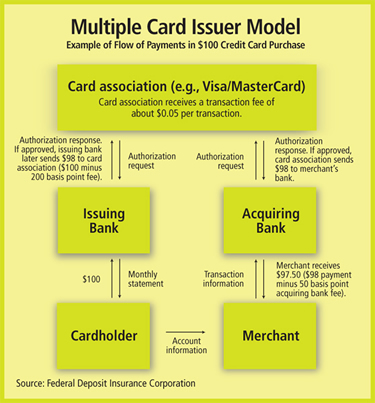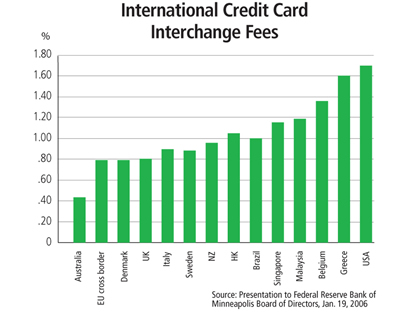Editor's note: The following is based on a presentation to the Minneapolis Fed's board of directors on Jan. 19, 2006.
 The steady shift from paper-based modes of payment such as checks and cash in favor of electronic payments including electronic fund transfers and credit/debit cards has now been well documented and much discussed in the United States, where electronic payment volume surpassed checks in 2003.
The steady shift from paper-based modes of payment such as checks and cash in favor of electronic payments including electronic fund transfers and credit/debit cards has now been well documented and much discussed in the United States, where electronic payment volume surpassed checks in 2003.
The Federal Reserve System has itself been transformed by this massive swing toward electronic payments. In response to diminished check volumes, the Fed has significantly consolidated its check processing operations. As Automated Clearing House volume has increased, the Fed has enhanced its check-to-ACH conversion and image-enabled processing, developed its international ACH services and improved its fraud detection capacity.
But it is credit and debit card payments that represent the most significant growth segment of electronic payments. The share of U.S. consumer expenditures paid for with cards has increased from about 3 percent in 1986 to 25 percent in 2000. Debit and credit cards represented less than 20 percent of noncash payment transactions in 1995; by 2003, they exceeded 40 percent of noncash transaction volume. According to recent estimates, 92 percent of households with incomes over $30,000 hold at least one credit card, with an average for all households of 6.3 cards.
With this growth has come increased scrutiny of both the benefits and costs of credit and debit card use. Indeed, the growth of credit card transactions has been paralleled by an accelerating trend in the number of legal battles between the retailers that accept them and the banks and networks that issue them, as well as a crescendo in calls by these parties for regulatory intervention (or lack thereof).
At the heart of the controversy is the "interchange fee," the fraction of each card transaction that the card's issuer retains. Combined with the additional though smaller fee levied by the retailer's own bank (to which the retailer first submits the transaction), the interchange fee cuts into retailer revenue, so the rise of interchange fees over time has fueled a growing conflict between retailers and card issuers.
In this article, I will try to describe key aspects of this controversy, discuss economic research surrounding it, provide some international context and, finally, explore the outlook for this emerging issue. To anticipate the conclusion, let me say that while the debate is rather stark in its outlines, and many parties appear quite certain as to its proper resolution, a closer look at the economics reveals that too little is known at this juncture either to settle the argument definitively or to justify regulatory intervention. Let me also say that in these remarks, I am speaking for myself, not for others in the Federal Reserve.
Parties of four
Essentially, a payment card transaction is a series of purchases among four parties, beginning with the customer, or cardholder. First, the cardholder purchases goods or services from the merchant. The merchant then essentially sells the transaction to its own bank (the acquirer). The acquirer in turn sells the transaction to the bank that issued that card (the issuer) through the card association's interchange and settlement system, which charges a small transaction fee. And ultimately, the cardholder repays the issuer.
Along the way, the acquirer and issuer each take a cut of the transaction. Out of a $100 retail purchase, say, the retailer may receive just $97.50 from the acquirer. Of this $2.50 discount, the card issuer's share—the interchange fee—constitutes between 70 percent and 90 percent (see chart).

This four-party card payment system (cardholder, merchant, acquirer, issuer) was established in the 1970s by the Bank of America, operating its BankAmericard system, the predecessor of Visa. There are now many variations on this basic model. American Express, for instance, established a three-party exchange, since it is both issuer and acquirer. But while the concept is straightforward, the complexity of interchange fees is daunting.
Both Visa and MasterCard have drawn up intricate interchange fee schedules describing fees that vary by the merchant's industry, the method of card acceptance, the type of card, transaction size and special deals. Supermarkets and other merchants that sell low-margin items pay lower rates, for example. Face-to-face transactions are typically charged a lower fee than mail-order transactions. Swiping is charged less than hand-keying. Traditional credit cards and "rewards" cards have different rates as well; merchants will receive a fraction less if a customer uses a rewards card. Fees also vary by the size of transaction. And finally, a few large merchants, including Wal-Mart, Sears and large grocery chains, have negotiated special interchange fee deals.
Four card networks share the $1.3 trillion U.S. credit card market (as of fiscal year ending September 30, 2004): Visa (39.8 percent market share), MasterCard (30.2 percent), American Express (23 percent) and Discover Card (7 percent). And the top 10 card-issuing banks range from J.P. Morgan Chase with nearly 43 million active accounts in 2004 to USAA Federal Savings with almost 2 million accounts (see table). As of 2004, the top five banks controlled 83 percent of all accounts, but still further concentration will result from two acquisitions announced last year: Bank of America buying MBNA and Washington Mutual acquiring Providian.

Source: Presentation to Federal Reserve Bank of Minneapolis
Board of Directors,
Jan. 19, 2006
Growing revenue and rancor
The bottom line is large. In 2004, card issuers earned approximately $25 billion in revenue from interchange fees, according to one estimate. The Wall Street Journal reported in January 2006 that the figure was approaching $30 billion, with an average interchange fee of 1.75 percent. According to one industry source, interchange revenues account for a quarter of card issuer revenues.
The average convenience store, according to the Journal, paid $31,000 in interchange fees in 2004, nearly as much as it made in pretax profits ($36,000), and the Food Marketing Institute (FMI) claims that the share of the grocery customer's dollar that goes to card companies and banks is almost double what goes to the grocer's bottom line.
As interchange fees in the United States gradually trend up—the FMI says that fees for credit cards have risen on five occasions since 1994, most recently in April 2005—retailers have become increasingly troubled. Over the past year, retailers and their trade groups have filed over 50 lawsuits against credit card associations and card-issuing banks; because these suits make similar claims, they may soon be consolidated as a class action lawsuit.
The merchant complaints fall along the following lines. Interchange fees represent "price fixing" by card association "cartels," they allege, and because merchant costs increase due to the fees, customers who pay with cash or checks end up subsidizing purchases by card users. Second, interchange fees are too high in the United States relative to elsewhere in the world, a difference that shouldn't exist given the large economies of scale in this country (see chart). Third, few merchants—Wal-Mart is an exception—have any ability to negotiate fees, a problem exacerbated by growing concentration among card issuers. And fourth, the rise in interchange fees bears no reasonable relationship to falling costs for card networks (card processing, borrowing, fraud and chargeback costs have all declined over recent years).

Source: Presentation at “Interchange Fees in Credit and Debit Card Industries,”
sponsored by Federal Reserve Bank of Kansas, 2005; see p. 175 of conference proceedings.
Card associations and issuing banks, not surprisingly, disagree with these arguments. The interchange fee is necessary to balance the relative demands of cardholders and merchants, thereby optimizing value. Setting fee schedules cooperatively isn't collusion, but rather an efficient means of negotiating among an extremely large number of issuers and acquirers. Merchant complaints about increases in interchange fees are misleading, argue card associations; growth in rates has been reasonable. This is especially true given the increase in consumer value from card use: More cards today have enhancements, such as rewards programs, annual fees have declined (down 50 percent since 1990), and the spread between average annual percentage rates and prevailing Treasury rates has fallen by 4 percent per year since 1990. Finally, card associations have been innovators; credit card fraud is down 7 percent annually since 1990, while volume has increased 16 percent.
The academic literature
Given such divergent positions, it's helpful to review what the academic literature has to say about credit card networks and the role of interchange fees. In a paper presented at a conference sponsored in May 2005 by the Federal Reserve Bank of Kansas City, economists David Evans and Richard Schmalensee note that with a few exceptions, "this topic languished in obscurity until around the turn of this century." As card transactions grew and retailers sought regulatory relief, "interest in interchange fees increased dramatically" among academics as well as banking regulators and competition authorities.
According to this burgeoning economic literature, card networks are two-sided markets in which businesses cater to two interdependent groups of customers. Card networks succeed only if they can attract cardholders and also induce merchants to accept those cards. Structurally, they're similar to auction houses, which cater to those who hope to sell and those seeking to buy, or shopping malls that lease space to merchants and then advertise to draw shoppers. In all such cases, write Evans and Schmalensee, the "businesses are intermediaries that add value if and only if they can appropriately coordinate the demands of two distinct groups of customers."
In essence, then, businesses in two-sided markets are matchmakers, and they succeed by expanding their networks, drawing in sufficient numbers of participants from both sides of the market. Economists say there are externalities involved, benefits that accrue to parties other than those who pay for them. If a shopping mall attracts a new store, for example, other businesses benefit because having more stores at the mall draws more customers. In the context of credit and debit cards, both merchants and customers benefit when card networks expand. And when such positive indirect externalities exist, participation may well be maximized when one side of the market pays a much lower price than the other.
"All general models of two-sided-platform markets," write the economists, "imply that profits may be maximized by highly asymmetric pricing in which one group is served at a price close to or even below marginal cost, and most or all gross margin is earned by serving the other group." In short, the economics of two-sided markets are very different from those in one-sided markets; as economists Stuart Weiner and Julian Wright put it in a separate paper for the Kansas City conference, "The two-sided markets' framework highlights the fact that the interchange fee is not a price for a single service, but instead acts as a balancing instrument." And in particular, pricing practices that might indicate monopoly power in a standard market analysis don't necessarily reveal a monopoly in a two-sided market.
Evans and Schmalensee point out that "economists have only scratched the surface [in understanding] pricing in two-sided markets in general and in the determination of interchange fees in particular." Nevertheless, they contend, several results "seem robust enough for policymakers to rely on":
- The socially optimal interchange fee is not, in general, equal to any interchange fee based on cost considerations alone.
- One can't assume that the interchange fee set collectively by an association is higher or lower than the socially optimal level.
- One can't assume that moving from the collectively set fee to a cost-based fee will increase or decrease social welfare.
- It is not clear that interchange fee regulation is the appropriate intervention for correcting [perceived] distortions in payments systems. "The interchange fee is a blunt instrument."
Market failure?
The question of whether interchange fees should be based on their costs is central to the debate between retailers and card issuers. The former argue that card networks operate as monopolies, fixing interchange prices well above the marginal cost of providing interchange services. In a standard one-sided market, such pricing practices are clear evidence of monopoly power. Thus, they argue, there is significant market failure that justifies government intervention. Card issuers, on the other hand, say that banks compete vigorously for cardholders and, moreover, that standard economic analysis doesn't apply to payment card networks.
A careful answer to the wisdom of cost-based interchange fees requires looking at all costs and benefits, not only those accrued by merchants, and examination of the alternatives to card transactions. While the surface has just been scratched in this regard as well, one study of the merchant costs and total social costs (net of benefits) of various payment methods shows that even though merchant costs for credit cards are high, credit card transactions have low social costs compared to other forms of payment (see chart). According to this preliminary study, a $54 grocery store transaction using cash would cost the merchant just $0.43, but would impose a net social cost of $1.79. The same transaction using a credit card would have a much higher merchant cost ($1.22), but a far lower social cost ($0.74).

U.S. regulatory action
As the controversy over interchange fees has grown, calls for regulatory relief have also increased. While the Fed regulates the banks that issue credit cards, it doesn't regulate the credit card industry or price competition in general. As Chairman Alan Greenspan wrote in a 2005 letter, "The Board's regulatory authority does not currently encompass regulating the interchange fees established by payments networks." Nonetheless, the Fed is paying close attention to the issue. The Federal Reserve Bank of New York hosted a conference in September 2005 titled "Antitrust Activity in Card-Based Payment Systems: Causes and Consequences." And of course, the Kansas City Fed held its May 2005 conference, "Interchange Fees in Credit and Debit Card Industries: What Role for Public Authorities?"
Price and competition issues more generally fall under the purview of the U.S. Department of Justice and the Federal Trade Commission, and they too are monitoring developments. Ironically, a 1998 DOJ action may have indirectly contributed to an increase in interchange fees. DOJ brought suit against Visa and MasterCard, claiming that they violated antitrust law by not allowing member banks to issue credit cards on other networks, such as American Express. The district court ruled in favor of DOJ, and in October 2004, the U.S. Supreme Court rejected Visa and MasterCard's appeal of the lower court decision. In response, Visa and MasterCard appear to have increased interchange fees to prevent banks from defecting to American Express, which pays a higher interchange fee—about 2.25 percent—to its bank partners.
International experience
While regulatory agencies in the United States have been reluctant to intervene on interchange fees, the overseas experience has been quite different: Some countries have taken or threatened regulatory action. But there, too, regulatory measures sometimes appear to have had unintended consequences.
In Spain, a 1999 agreement among banks, networks, merchants and the Ministry of the Economy resulted in declining interchange fees. In Australia, the Reserve Bank has mandated that interchange fees be lowered. It has also eliminated the "no-surcharge" rules under which credit card companies forbid merchants from charging customers a fee for using cards.
Similarly, the Bank of Mexico has proposed lowering interchange fees, and in January, according to the American Banker, Mexican bankers agreed to lower fees by 0.4 percentage points. At the Kansas City Fed conference, Guillermo Ortíz, governor of the Bank of Mexico, said, "If we know, or we have high suspicions, that the industry is heavily concentrated, that there are barriers to entry, that commissions are too high, et cetera, without fixing prices, we can move in the right direction. We don't know exactly what the level of fees should be, but we know they should probably be lower just by looking at the data." In Mexico, where cash is used in seven out of eight consumer purchases, it's thought that lower interchange fees may persuade more retailers to accept cards.
Under pressure from the European Commission, Visa has agreed to gradually reduce cross-border interchange fees by 2007, and fees have begun to decline. And in the United Kingdom, the Office of Fair Trading is investigating MasterCard interchange fees. "In effect, interchange fees act like a tax on retail transactions that is paid by all consumers in shops that accept credit cards," according to the Office, which is concerned that those who pay with cash (often from lower-income groups) are subsidizing card payers (predominately from higher-income groups).
In some of these countries, card associations have responded to declining interchange fees by generating revenue through other means that regulators may not have foreseen or desired. In Australia and Spain, for instance, where interchange fees have declined due to regulatory pressure, annual cardholder fees have increased; in Australia, interest-free periods have shortened and rewards programs have become less generous. On the other hand, in the United Kingdom, while interchange fees have fallen, both annual fees and introductory rates remain relatively low.
The United States: Litigation and response
In the United States, the major response to rising interchange fees has come from merchants and their associations. As mentioned earlier, over 50 lawsuits are pending in various U.S. courts, accusing credit card associations and issuing banks of collusion in setting interchange fees at levels well above those that would be set by a competitive market, of adopting rules that prevent businesses from negotiating lower rates and of holding secret meetings to promote arbitration, in violation of antitrust laws. The suits often seek injunctive relief or remedies such as eliminating no-surcharge rules.
These suits fall in the shadow of earlier cases. In litigation against Visa, large merchants including Wal-Mart, Sears and Safeway argued that Visa's requirement to "honor all cards" was improper in that fees for various types of cards should be set in proportion to the risks each transaction poses to the network. As part of a 2003 settlement, Visa and MasterCard agreed to pay retailers collectively $3 billion over 10 years, temporarily reduce debit card fees, permanently change the "honor all cards" rule as it relates to debit cards and establish lower transaction fees. But the settlement didn't address requirements for merchants to accept premium credit cards.
The largest legal shadow may have been cast by the 1984 decision in National Bancard Corp. (NaBanco) v. Visa U.S.A., in which the court rejected NaBanco's challenge that interchange fees were illegal price fixing. Merchant groups argue today that changes in technology and market structure over the last 20 years warrant a change in the NaBanco precedent.
Card associations have responded vigorously to these actions and to the general criticism of their interchange fees. In early November 2005, Visa announced that it would restructure its board of directors to include a majority of independent directors. Currently, Visa's board consists of 14 directors from member banks and two from Visa's management. The new board will have 17 seats, comprising eight independent directors, seven directors from member institutions and two nonvoting Visa management directors. Later in November, MasterCard shareholders approved management proposals that would similarly establish a new board structure to include a majority of independent directors, and also make a transition to a publicly held company.
Card associations have also sought to mitigate the impact of impending lawsuits in other ways. A recent Reuters article reported that members of the International Card and Payments Council, a London-based group of international cards executives "intended to lobby the Federal Reserve and other regulators" to intervene in the class action suit that may soon form out of the many individual lawsuits. "The Fed 'should tell the court to dismiss the lawsuits or offer a resolution that will prove the least disruptive to the banking system and the U.S. economy,' said Duncan MacDonald, a consultant and former general counsel for the cards business of Citigroup's Citibank."
The outlook
The Fed, clearly, has no jurisdiction in this dispute and will not be intervening as either side would wish. Undoubtedly, the matter will play out in the courts for many years to come. But the academic research to date indicates that both parties will have a difficult time establishing a clear picture of the credit and debit card market, and the economics thereof.
"Since there is so much uncertainty about the relation between privately and socially optimal interchange fees," write Evans and Schmalensee, "the outcome of a policy debate can depend critically on who bears the burden of proof. ... [I]f antitrust or other regulators had to show that [fee-reducing] intervention would improve welfare, they could not do so. ... By the same token, ... if card associations had to bear the burden of proof ... it would be difficult for them to demonstrate that they set socially optimal fees."
Merchants, apparently, have taken this to heart. In a June 2005 press release announcing a class action lawsuit against Visa, MasterCard and member banks, the merchants' lead attorney claimed,
Visa and MasterCard have previously been found to have "market power" in the relevant markets, so Visa, MasterCard and the banks now have the burden of proving that they have set the interchange fees at the correct competitive level. Even Visa's own economists admit they cannot satisfy this burden.
Bank and card association attorneys undoubtedly have a very different perspective as to who bears the burden and what constitutes proof. And given the complexity of the issues and the divisiveness of the controversy, the outcome of the dispute is by no means clear. But as credit and debit card use continues to expand in the United States and internationally, it is an outcome in which we all have a stake.
Related LinksInterchange Fees in Credit and Debit Card Industries: What Role for Public Authorities? conference sponsored by the Federal Reserve Bank of Kansas City, May 2005.
Antitrust Activity in Card-Based Payment Systems: Causes and Consequences, conference sponsored by the Federal Reserve Bank of New York, September 2005 |





